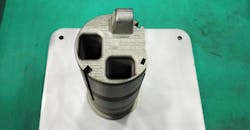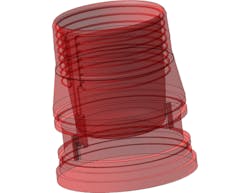3D Printing Not Yet Ready to Disrupt Plastic Injection Molding
Product developers and engineers who design and manufacture plastic parts now have a powerful new weapon in their arsenal: 3D printing. This disruptive technology has great promise for rapid prototyping and low-volume manufacturing, but is it ready to replace high-volume plastic injection molding using dedicated metal tools and dies?
The short answer: 3D printing is better used as a complement to plastic injection molding rather than as competition, though that may change. Here’s where we currently stand and what the future may hold.
Plastic 3D Printing vs. Injection Molding
Plastic injection molding using dedicated tools and dies has been around since 1872, although it took until after World War II for it to really take off. That’s well over 100 years of development, so designers know how to dial it in for maximum efficiency in mass production. But there are still some limitations. The first of these is the design of the part itself. You can’t make hollow walls, for example, and internal threads can only be made with inserts that must be unloaded from the molds and parts after each cycle.
The advantage of 3D printing is that it can make these and other previously impossible or impractical geometries, as well as internal-lattice structures, with optimal strength and low weight. These are huge engineering advantages that can’t be done conventionally or without high costs. But 3D printing takes much longer per part and is only commercially viable for a relative handful of parts. Once volumes increase, plastic injection molding is currently the only way that makes financial sense for many types of parts. Also, the surface finish quality of 3D parts is (so far) pretty poor, but that’s one area that’s rapidly improving.
We are also seeing improvements in how quickly near-net finished parts come out of printers such as HP’s Jet Fusion line. These improvements have not matched initial expectations, though eventually some company will work all the bugs out of this process. But for now, 3D printing will remain viable only for low-volume bridge production or rapid prototyping.
It took complex modeling software to determine the best architecture for internal, conformal cooling channels for this cylinder.
3D Plastic Printed Injection Molds
It is possible to make injection mold tools using 3D printing, albeit with some caveats. There are definitely limitations in durability, for one thing. Plastic molds might be good for—at most—100 shots, and usually much less. There are also major tradeoffs in gate design and location, and tool-wall thickness must be increased to provide more strength.
That said, operators can put an aluminum resin “skin” coating over the tool to increase wear life, and this makes the entire build process much faster and cheaper than using a true aluminum tool. For short runs of basic part shapes, this might be a viable niche solution.
3D Metal Printing and Conformal Cooling
The highest potential for improving part quality and speed lies with metal 3D-printed, conformally-cooled injection mold tools. Right now, the vast majority of conventional tools uses line-of-sight cooling channels machined out of aluminum or steel cores and cavities.
These are relatively straightforward to manufacture, but they are inherently limited in their ability to follow the geometries for complex parts. As such, cooling efficiency decreases, with corresponding increases in cycle times (and therefore, costs). Part quality can also suffer with sink marks, weld lines, and distortions caused by unbalanced heat transfer in the mold.
A plastic injection mold tool made with 3D printing uses cooling channels that conform closely to the shape of the cavity. These channels deliver water exactly where it’s needed for maximum efficiency, and in the right volume. Conformal channels printed this way can have different cross-sectional sizes and shapes at different points along their lengths as necessary, and also be printed close to the tool wall. The results of this improved cooling are drastically reduced cycle times and significantly improved part quality.
To get the most out of this innovation, tooling engineers will need to become more familiar with sophisticated mold-flow analysis to model heat transfer. Also, printing such a tool successfully is a complex operation that requires another skilled engineer operating a 3D printer the can create metal parts. Tool size will be limited to the size of the print bed, which is smaller than conventional CNC machines allow.
Also, there are fewer raw materials to choose from. Taken together, 3D printed injection mold tools are likely to be more expensive than their conventional counterparts, but these costs can be recovered over a long production runs due to faster cycle times and better parts.
Outlook for 3D Printing and Plastic Injection Molding
The relationship between 3D printing and plastic injection molding is complicated. The 3D printing conformal cooling channels in metal parts proves the two technologies can be complementary to each other. However, many still hope plastic 3D printing advances to the point it becomes a true high-volume production method that absorbs a bigger share of the plastic injection molding market. All we can do is wait and see what’s in store as these technologies continue to be improved over the years to come.
Gordon Styles is president and CEO of Star Rapid, a company that specializes in rapid prototyping, rapid tooling, and low-volume manufacturing of custom parts.


